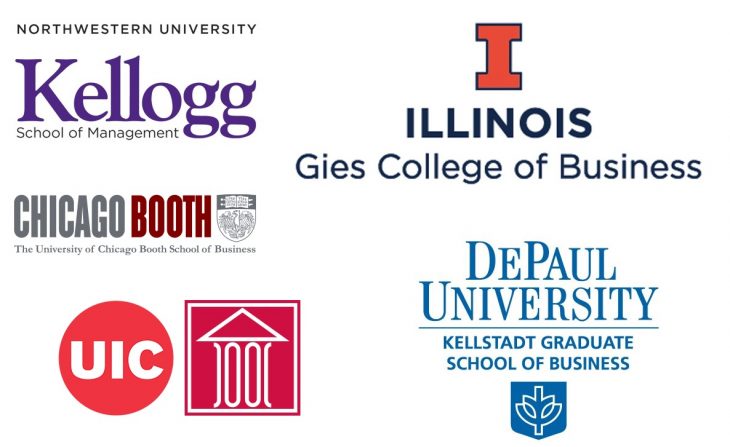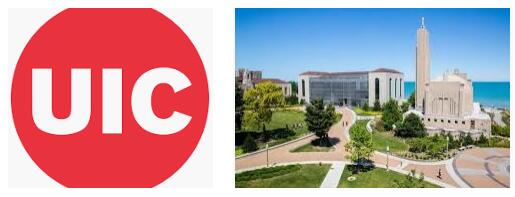Search top business school MBA programs in the state of Illinois. Find latest rankings of MBA schools national wide and state wide. For detailed admissions statistics and graduate employment rate, check the following table for each top-ranked business college within Illinois, with acceptance rate, average GPA and GMAT scores, as well as well tuition and starting salary information of all best MBA universities in Illinois.
Illinois is home to some of the best business schools in the country, offering students a variety of options for pursuing their studies. The University of Illinois at Urbana-Champaign is one of the top choices for those looking to study business in Illinois. The College of Business at the University of Illinois provides students with access to a wide range of degree programs, from undergraduate to graduate and even executive education. With a focus on experiential learning, the college offers students the opportunity to gain real-world experience through internships and other hands-on activities. Additionally, the college has strong connections with the local business community, allowing students to network and expand their professional contacts while they gain knowledge of the Illinois economy.
The Kellogg School of Management at Northwestern University is another excellent option for those interested in studying business in Illinois. Kellogg offers a variety of degree programs including MBA, MS, and PhD programs as well as specialized certificates in areas such as finance and marketing. In addition to providing traditional classroom instruction, Kellogg also provides opportunities for experiential learning through internships and other hands-on experiences. The school also offers an Executive MBA program that allows working professionals to earn an advanced degree while maintaining their current job responsibilities. With its emphasis on practical application and leadership development, Kellogg is an excellent choice for anyone looking for a top-notch business education in Illinois. 
| National Ranking | Best Business MBA Programs |
| 5 | Northwestern University (Kellogg) (Evanston, IL) Acceptance rate: 21.1% Average GMAT score: 712 Average undergraduate GPA: 3.54 Tuition: Full-time: $54,000 per year Enrollment (full-time): 1,201 Average starting salary and bonus: $130,092 Full-time graduates employed at graduation: 83.8%  |
| 6 | University of Chicago (Booth) (Chicago, IL) Acceptance rate: 21.9% Average GMAT score: 719 Average undergraduate GPA: 3.52 Tuition: Full-time: $53,400 per year Enrollment (full-time): 1,160 Average starting salary and bonus: $133,424 Full-time graduates employed at graduation: 82.1%  |
| 39 | University of Illinois–Urbana-Champaign (Champaign, IL) Acceptance rate: 28.1% Average GMAT score: 650 Average undergraduate GPA: 3.40 Tuition: In-state, full-time: $19,975 per year; Out-of-state, full-time: $29,975 per year Enrollment (full-time): 226 Average starting salary and bonus: $85,916 Full-time graduates employed at graduation: 69.2%  |
| 70 | DePaul University (Kellstadt) (Chicago, IL) Acceptance rate: 44.4% Average GMAT score: 625 Average undergraduate GPA: 3.22 Tuition: Full-time: $900 per credit Enrollment (full-time): 109 Average starting salary and bonus: $73,801 Full-time graduates employed at graduation: 66.7%  |
| 124 | University of Illinois–Chicago (Liautaud) (Chicago, IL) Acceptance rate: 43.2% Average GMAT score: 580 Average undergraduate GPA: 3.27 Tuition: In-state, full-time: $18,584 per year; Out-of-state, full-time: $30,582 per year Enrollment (full-time): 111 Average starting salary and bonus: $66,765 Full-time graduates employed at graduation: 27.3%  |
Illinois is located in the midwestern United States, bordered by Wisconsin, Iowa, Missouri, Kentucky, Indiana and Michigan. It has a population of approximately 12.8 million people with Springfield as its capital city and Chicago as its largest city. It has a wide range of climates from humid continental to humid subtropical due to its elevation and latitude. Agriculture has been an important part of Illinois’s economy since before statehood with corn and soybeans being two of its major crops. Other major industries include manufacturing, finance and insurance, health care and technology. Illinois is also home to many professional sports teams such as the Chicago Cubs (MLB), Chicago Bears (NFL), Chicago Bulls (NBA) and Kane County Cougars (minor league baseball). With its stunning natural beauty, vibrant culture and unique lifestyle it’s easy to see why so many people choose to live in Illinois!
Chicago, Illinois
Chicago has about 2,700,000 residents, with a population density of about 4,575 people/ km2. A huge metropolitan area grew up around the city, including the cities of Joliet, Naperville, and several other Illinois communities, as well as neighboring Wisconsin and Indiana. In total, about 9,460,000 people live in this metropolis.
The racial composition of the population of Chicago:
- White – about 45%
- Blacks (African Americans) – about 33%
- Asians – about 5.5%
- Native Americans (Indians or Eskimos of Alaska) – less than 1%
- Other races – about 14%
- Two or more races – about 3%
- Hispanic or Latino (of any race) – about 29%
The largest ethnic (national) groups among the residents of the city: Mexicans (21.4%), Irish (6.6%), Germans (6.5%), Poles (5.3%), Puerto Ricans (3.8%), Italians (3.5%), Assyrians (3.5%), British (2%), Filipinos (1%), Russians (1%), Swedes (0.9%), French (0.9%).
Chicago is a “city of skyscrapers”. It was here that in 1884, shortly after the “Great Chicago Fire”, the first high-rise building in the United States (and in the world) with a load-bearing metal frame was built – Home Insurance Building (Home Insurance Building, 10 floors, 42 meters), it is from here that “fashion skyscrapers rapidly spread around the world. Today, the “high-rise” landscape of Chicago is comparable in terms of building density only to Manhattan in New York.
The largest skyscraper in modern Chicago is the Willis Tower ( Willis Tower, formerly Sears Tower, 108 floors, 442 meters), built in 1973, which was the tallest building in the world until 1998. In second place is Trump Tower (Trump Tower, 2009, 96 floors, 415 meters), in third is St. Regis Chicago (St. Regis Chicago, 2020, 101 floors, 365 meters). At the same time, many of the “old” skyscrapers were preserved in Chicago: the Fine Arts Building (1884), the building of the Chicago Board of Trade (1930), Merchandise Mart (1930, was the largest building in the world by area until 1943) other.
Most of the Chicago skyscrapers are located in the central, historical and business part of the city, known as the “Loop” (Loop). It is here that the headquarters and representative offices of many large companies are concentrated, as well as diplomatic missions, educational institutions, shops, restaurants, parks and other tourist attractions.
